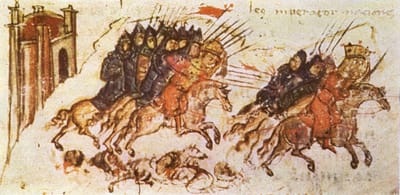Bulgars

The Bulgars became semi-sedentary during the 7th century in the Pontic-Caspian steppe, establishing the polity of Old Great Bulgaria c. 630–635, which was defeated by the Khazar Empire in 668 AD. In c. 679, Khan Asparukh conquered Scythia Minor, opening access to Moesia, and established the Danubian Bulgaria – the First Bulgarian Empire, where the Bulgars became a political and military elite. They merged subsequently with established Byzantine populations, as well as with previously settled Slavic tribes, and were eventually Slavicized, thus forming the ancestors of modern Bulgarians.
The remaining Pontic Bulgars migrated in the 7th century to the Volga River, where they founded the Volga Bulgaria; they preserved their identity well into the 13th century. The modern Volga Tatars and Chuvash people claim to have originated from the Volga Bulgars.
The first clear mention and evidence of the Bulgars was in 480, when they served as the allies of the Byzantine Emperor Zeno (474–491) against the Ostrogoths.
According to D. Dimitrov, the 5th-century History of Armenia by Movses Khorenatsi speaks about two migrations of the Bulgars, from Caucasus to Armenia. The first migration is mentioned in the association with the campaign of Armenian ruler Valarshak (probably Varazdat) to the lands "named Basen by the ancients... and which were afterwards populated by immigrants of the vh' ndur Bulgar Vund, after whose name they (the lands) were named Vanand". The second migration took place during the time of the ruler Arshak III, when "great disturbances occurred in the range of the great Caucasus mountain, in the land of the Bulgars, many of whom migrated and came to our lands and settled south of Kokh". Both migrations are dated to the second half of the 4th century AD. The "disturbances" which caused them are believed to be the expansion of the Huns in the East-European steppes. Dimitrov recorded that the toponyms of the Bolha and Vorotan rivers, tributaries of the Aras river, are known as Bolgaru-chaj and Vanand-chaj, and could confirm the Bulgar settlement of Armenia.
Bulgarian Empires
The First Bulgarian Empire (681–1018) had a significant political influence in the Balkans. In the time of Tervel (700–721) the Bulgars helped Byzantines two times, in 705 the Emperor Justinian II to regain his throne, and 717–718 defeating the Arabs during the siege of Constantinople. Sevar was the last ruler from the Dulo clan, and the period until c. 768–772 was characterized by the Byzantino-Bulgar conflict and internal crisis. In the short period followed seven rulers from the Uokil and Ugain clan. Telerig managed to establish a pacific policy with Byzantium, and restore imperial power.
During the reign of Khan Krum (803–814), the Empire doubled its size, including new lands in Macedonia and Serbia. He also successfully repelled the invading force of the Byzantines, as well defeated the Pannonian Avars where additionally extended the Empire size. In 865, during the reign of Khan Boris I (852–889), the Bulgars accepted Christianity as the official religion, and Eastern Orthodoxy in 879. The greatest expansion of the Empire and prosperity during the time of Simeon I (893–927) is considered as the Bulgarian Golden Age. However, from the time of Peter I (927–969) their power declined. The Hungarians, Kievan Rus' Slavs, as well Pechenegs and Cumans held many raids into their territory, and so weakened were eventually conquered in 1018 by the Byzantine Empire.